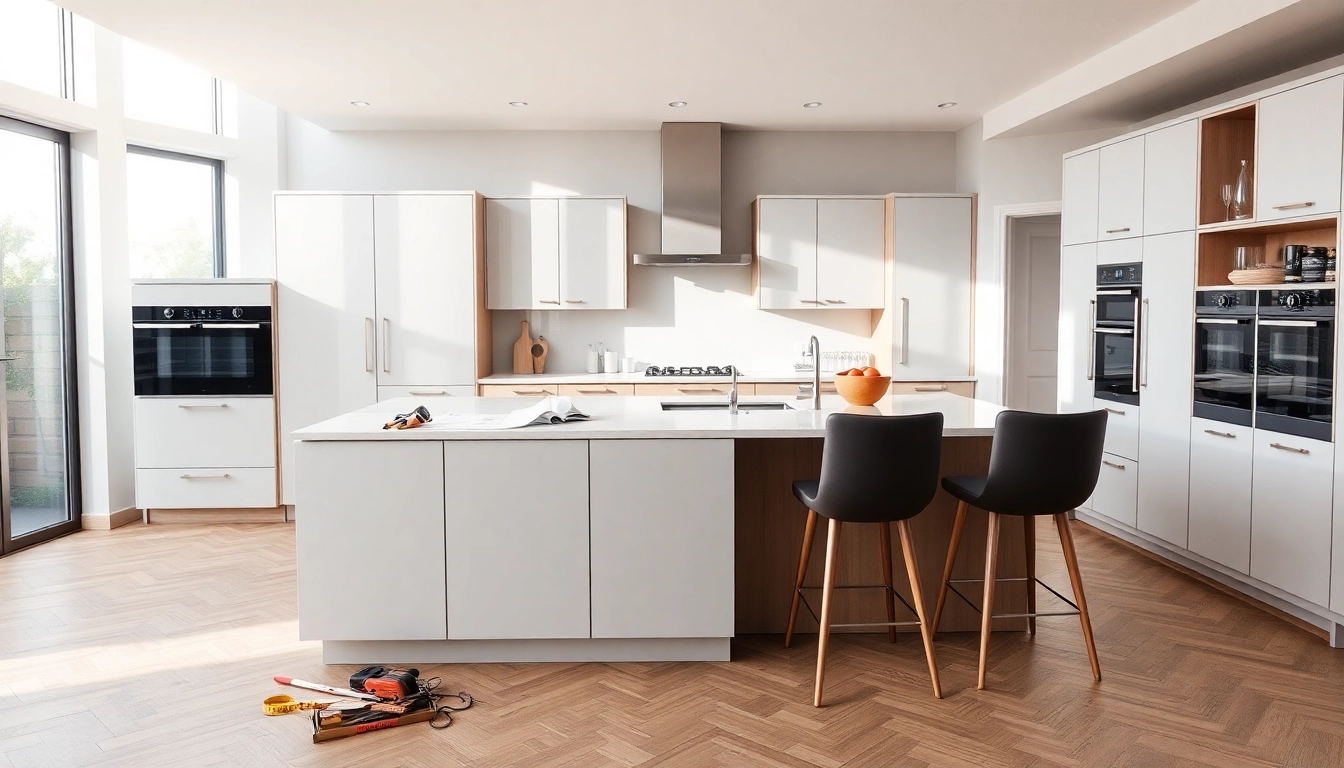Understanding the Role of Kitchen Fitters
Kitchen fitters play a vital role in transforming homes by ensuring that kitchens are installed efficiently and to a high standard. They are responsible for a range of tasks that include measuring, installing, and finishing kitchen elements, from cabinets and countertops to sinks and appliances. Successful kitchen fitters possess a blend of technical skills and design sensibility, positioning them as crucial players in home renovation projects. If you are searching for skilled kitchen fitters, understanding what they do can help you make informed decisions.
What Services Do Kitchen Fitters Provide?
Kitchen fitters offer a plethora of services, typically including:
- Design and Planning: Collaborating with homeowners and designers to create a functional layout that maximizes space and meets the client’s needs.
- Cabinet Installation: Installing various types of cabinets, including wall-mounted and base cabinets, ensuring they are fitted securely and aligned properly.
- Countertop Installation: Measuring and installing countertops, which could range from laminate to quartz or granite, depending on the homeowner’s preference.
- Appliance Installation: Properly fitting kitchen appliances such as ovens, dishwashers, and refrigerators, ensuring they meet safety requirements and are integrated seamlessly into the design.
- Plumbing and Electrical Work: Some kitchen fitters may also handle or coordinate plumbing and electrical work, including the installation of faucets, sinks, lighting fixtures, and more.
- Finishing Touches: Applying finishing touches like backsplashes, trim, or paint, ensuring the kitchen is not just functional but visually appealing.
How to Choose the Right Kitchen Fitter
Selecting the ideal kitchen fitter requires careful consideration of several factors:
- Experience: Look for fitters with extensive experience in kitchen installations. Their expertise can greatly influence the quality of the final outcome.
- Portfolio: Review their previous work to assess the quality and style of their installations, ensuring it aligns with your vision.
- References and Reviews: Speak to previous clients or read online reviews. Feedback from others can provide insight into the fitter’s reliability and quality of work.
- Insurance and Certification: Ensure they have the necessary certifications and insurance, offering you peace of mind during the installation process.
- Clear Communication: The best kitchen fitters communicate effectively, listening to your ideas and providing expert suggestions to enhance your project.
Importance of Professional Installation
Opting for professional kitchen installation can yield numerous advantages:
- Quality Assurance: Professionals bring experience and technical skills, ensuring that all installations meet industry standards.
- Time Efficiency: Professional fitters work efficiently to complete the project in a timely manner, minimizing disruption to your home life.
- Warranty: Many kitchen fitting services come with warranties, providing reassurance that any issues will be addressed post-installation.
- Value Addition: A professionally fitted kitchen can significantly enhance the value of your home, making it an attractive feature for potential buyers.
Essential Skills and Qualifications of Kitchen Fitters
Key Skills Every Kitchen Fitter Should Have
The role of a kitchen fitter demands a variety of skills, including:
- Technical Skills: Proficiency in using tools and machinery commonly employed in fitting kitchens.
- Attention to Detail: An eye for detail is crucial to ensure accuracy in measurements and alignment.
- Problem-Solving Skills: The ability to troubleshoot unforeseen issues that may arise during installation.
- Customer Service Skills: Good interpersonal skills to foster positive relationships with clients, ensuring their visions are realized.
- Physical Fitness: The job often requires physical labor, including lifting and carrying heavy materials.
Certifications and Training Programs
Formal training and certification can elevate a kitchen fitter’s credibility:
- NVQs in Bench Joinery: This certification provides essential skills related to woodworking, uplifting a fitter’s qualifications significantly.
- Apprenticeships: Engaging in hands-on experience while training under a seasoned fitter helps in learning the trade effectively.
- Health and Safety Training: Understanding safety protocols is critical to avoiding accidents and ensuring a safe working environment.
Common Tools Used by Kitchen Fitters
Kitchen fitters utilize a range of specialized tools to perform their tasks seamlessly:
- Measuring Tools: Tape measures, levels, and squares to ensure accurate measurements and alignment.
- Power Tools: Saws, drills, and nail guns for efficient cutting and assembly of materials.
- Hand Tools: Hammers, screwdrivers, and wrenches for detailing and finish work.
- Safety Gear: Items such as hard hats, gloves, and goggles are critical for ensuring safety during installations.
Planning Your Kitchen Renovation
Budgeting for Kitchen Fitting Services
A detailed budget is paramount for a successful kitchen renovation. Your budget should encompass:
- Labor Costs: On average, kitchen fitters charge between £250 and £500 per day, depending on skill level and project complexity.
- Materials: Allocate funds for cabinets, countertops, fixtures, and appliances, which can vary greatly in price based on quality.
- Unexpected Expenses: Set aside 10-15% of your budget for unforeseen issues that may arise during installation.
Choosing the Right Materials for Your Kitchen
Selecting suitable materials is critical for both aesthetics and durability:
- Counters: Choices include granite, quartz, laminate, and hardwood; each has its pros and cons.
- Cabinets: Solid wood, particle board, and MDF are common materials for cabinets, with varying price points and finishes.
- Flooring: Options like tile, hardwood, or vinyl each offer different benefits in terms of maintenance and style.
Timeline: What to Expect During Installation
Understanding the typical timeline helps manage expectations:
- Preparation: Initial planning and design can take two to four weeks, depending on complexity and client decisions.
- Demolition: Removing the old kitchen may take a few days, particularly if extensive work is required.
- Installation: The actual fitting process generally lasts from one to three weeks, depending on the size of the kitchen and the number of fitters involved.
- Final Walkthrough: Once the installation is complete, a thorough examination with the client allows for any adjustments before finalizing the project.
Best Practices for Working with Kitchen Fitters
Communication: Setting Clear Expectations
Clear communication greatly enhances the installation process:
- Initial Consultations: Clearly outline your vision, budget, and timelines during the initial meetings.
- Regular Updates: Schedule check-ins to stay informed on progress and any issues that arise.
- Documentation: Having everything in writing can prevent misunderstandings regarding costs and expectations.
Dealing with Common Challenges
Kitchen renovations often encounter challenges. Here are ways to navigate them:
- Delays: Remain flexible with timelines; they can shift due to material availability or unforeseen complications.
- Design Changes: Being open to professional advice when issues arise can help in finding effective solutions.
- Budget Overruns: Monitor expenses closely and communicate promptly with your fitter if costs are escalating.
Post-Installation: Tips for Maintenance
Once your kitchen is installed, proper maintenance is key to longevity:
- Cleansing: Regularly clean surfaces and fixtures with appropriate materials to prevent wear and tear.
- Inspection: Conduct routine checks for any loose fixtures or signs of damage to address them early.
- Professional Follow-Up: Don’t hesitate to contact your kitchen fitter for helping with adjustments or warranty services.
Finding the Best Kitchen Fitters Near You
How to Research Kitchen Fitting Companies
Finding the right kitchen fitting company requires strategic research:
- Online Directories: Use platforms like Yelp or Angie’s List to find local fitters along with customer ratings.
- Community Referrals: Ask friends, family, or neighbors for recommendations based on their experiences.
- Professional Networks: Networking with designers or real estate agents may provide trusted referrals.
Reading Reviews and Testimonials
Feedback from others is invaluable. Focus on the following:
- Consistency: Look for companies with a high number of positive reviews over a significant period, indicating reliability.
- Response to Complaints: Assess how the company handles negative feedback; proactive responses reflect professionalism.
- Detailed Narratives: Reviews that provide in-depth accounts of customer experiences can be particularly enlightening.
Requesting and Comparing Quotes
Obtaining multiple quotes is crucial for making an informed decision:
- Written Quotes: Always ask for detailed, written estimates that break down individual costs for labor, materials, and additional services.
- Understanding Inclusions: Thouroughly review what services are included in the quote; some may entail additional charges.
- Follow-Up Questions: Don’t hesitate to ask questions about any part of the quote to avoid surprise costs during installation.




